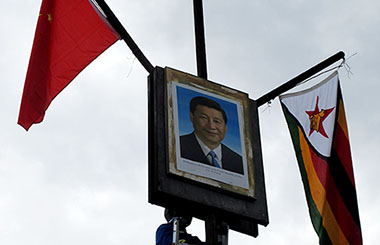
Internet-linked smartphones helping fuel China's outbound tourism boom
For an adventurous traveler like Chen Yu, deciding where to go on holiday used to involve hours of scouring guidebooks for tips on attractions, decent hotels and how to get around in a foreign land.
"Now all I need is my smartphone," says the 35-year-old from Beijing.

The rapid advancement in technology in recent years means even cheap mobile phones are now effectively palm-top computers, giving users instant access to real-time information on almost any topic.
Avid travelers have been among the biggest beneficiaries of this technological revolution - they can now book flights and hotels in an instant, use "digital wallets" to buy souvenirs, post reviews on the fly, and download apps that offer detailed maps and guides of far-flung places, all in their native language.
"An app can lead me straight to a place serving authentic food, a popular show or to an experience that gives me the taste of the local life," Chen says.
The development in mobile Internet has undoubtedly contributed to the boom in China's outbound tourism, which led to the country becoming the world's biggest source of tourists in 2012.
According to official data, Chinese tourists were expected to make 120 million trips abroad in 2015. That would be an increase of 16 percent year-on-year and roughly 12 times the figure recorded at the turn of the century.
Bank of America Merrill Lynch has estimated the number could hit about 174 million by 2019, with tourist spending increasing to $264 billion (244 billion euros).
"Technological advances have been key, as the Internet has reduced travel costs and made exotic destinations more viable (for Chinese tourists)," says Zhu Zhengyu, an analyst at Analysys International. "It has also led to more Chinese traveling independently rather than in groups."
And it's not just tourists who have benefited; travel agencies have also been able to reduce costs, while tech firms have latched on to the opportunities created by a fast-growing market.
"The Internet has allowed travel agencies to close brick-and-mortar offices, cut out the middleman and gain easier access to target customers," Zhu says. "Since 2014, many companies have also launched smartphone apps aimed at Chinese travelers, providing services like car rental and restaurant reviews, which removes the language barrier and facilitates independent travel."
In fact, despite China coming late to the Internet, studies suggest the nation's tourists are now the most connected in the world.
The Chinese International Travel Monitor, compiled by online booking agency hotel.com, says at least 50 percent of tourists arranged a holiday through a smartphone app in 2015, up 17 percent year-on-year.
In December, TripBarometer, the research arm of TripAdvisor, also released its 2016 Travel Trends. The report includes a poll of 44,000 global travelers that found 75 percent now see mobile devices are the most essential item for a holiday, overtaking toiletries. Among the Chinese respondents, it was 87 percent.
Tech companies have been quick to see the potential in China's outbound tourism market.
One example is Yidao Yongche, an Uber-like app that provides Chinese-speaking drivers to Chinese travelers in 25 cities overseas. Launched as a car rental website in 2010, the company shifted focus when mobile Internet devices started to become popular in China.
"Most Chinese don't speak English, so they find it difficult to communicate with foreign drivers after they land in another country," says founder and chief executive Zhou Hang.
With offices in Paris, London, Edinburgh and Manchester in Europe, as well as New York, San Francisco, Los Angeles and Phoenix in the US, Yidao Yongche offers services, that include airport pickups for passengers who book flights through Ctrip, a major online travel agency and an investor in the app.
China is also arguably the most competitive market for websites and apps that allow tourists to post reviews and swap travel stories.
TripAdvisor is the biggest player in the West and beyond; at least half of its total revenue is generated in North America, with 33 percent coming from Europe and the Middle East. Yet in China, local rivals such as Mafengwo and Qyer are providing stiff competition.
Founded in 2010, Mafengwo is a major tourist information-sharing website and has invested heavily in its mobile Internet services. The company says its app, launched in 2015, has been downloaded 280 million times and has more than 80 million active users.
"The future for tourism apps lies in tapping local resources," says Feng Yao, Mafengwo's director of tourism research, adding that Mafengwo opened scores of offices in overseas markets in 2015, such as in Phuket and Chiang Mai in Thailand, and are now working with local tourism companies to offer services at lower prices directly to users.
Shanghai-based Dianping, a business listings website similar to Yelp, has also extended its reach to 860 cities in more than 200 countries and regions overseas, with the most-common searches being for services in Japan, Thailand and South Korea.
Thanks to the technology, industry insiders and analysts see no slowdown ahead for the growth in outbound tourism in China.
VisitBritain, the official tourism board of the United Kingdom, expects Chinese travelers to be spending more than 1 billion pounds ($1.47 billion; 1.35 billion euros) a year in the country by 2020. By that year, the annual number of Chinese visitors to the US is also forecast to double to 4 million, according to US National Travel and Tourism Office.
"Undoubtedly, 2015 will mark the fourth consecutive year of China as the world's top source for tourists," says Jiang Yiyi, director of the International Tourism Development Institute.
"The major reason for the growth lies in the policy changes that began in 1997 to enable more Chinese to travel abroad, which unleashed a high demand for overseas travel," she says. "Since then, increased disposable incomes, extended national holidays, relaxed visa restrictions for Chinese travelers and the rising value of the renminbi (China's currency) have all contributed to the boom."
Some have compared the current trend to when Japanese tourists began going abroad three decades ago. From the mid-1980s through to the 1990s, the number of Japanese heading overseas swelled from 4 million to 16 million, while at the same time the nation's per capita GDP rose from $10,000 to $35,000.
"Before (the 1980s), Japanese tourists liked to stay onshore for vacations. But as they became richer all of a sudden they started to travel more. The same thing is happening in China, but at a much steeper rate," says Daniel Wilson, an economist at ANZ.
Jiang agrees there are common features to these trends, such as a surging economy, rising currency valuation and trade surplus. However, unlike Japan, she says China has not officially encouraged outbound travel as a way to balance its trade deficit, although it has had an effect.
One big difference is the sheer number of Chinese tourists. According to the Bank of America Merrill Lynch report, the current trend "is going to be bigger and will last longer given China's population of 1.3 billion versus Japan's population of 127 million."
Chinese travelers are already seen as the world's biggest spenders. In 2014, they spent a total of $164.8 billion, four times more than in 2008, according to the China Tourism Academy, a government research institute. Almost 90 percent of that was spent shopping.
Of course, the slowdown in the Chinese economy has led to concern in places that have come to rely on Chinese tourist spending. Yet Jiang remains confident: "As tourism is discretionary consumer spending, it is relevant, yet not closely linked to, the country's GDP. But even though there will be a slowdown in GDP growth, you're still going to see more tourists and you're still going to see increased spending."
She says her confidence comes partly from the fact that less than 10 percent of Chinese mainlanders have passports and "only 49 countries and regions have so far granted Chinese citizens visa-free or visa-on-arrival access".
It means the market still has a lot of growth potential, which can be unlocked by more flights to various destinations and relaxed visa policies.
Data from OAG, which compiles air travel intelligence, show 298,353 scheduled domestic and international flights left Chinese airports in November, with capacity on international flights up 20 percent year-on-year. South Korea and Japan lead the way in terms of available capacity, with Vietnam the fastest-growing market.
The figures highlight strong growth in several smaller markets, as Chinese and foreign carriers compete to serve outbound Chinese travelers.
Flights to and from countries such as Afghanistan, Belarus, the Czech Republic and Fiji were launched in 2015, while capacity on flights to countries like Iraq, Iran, Pakistan and Turkmenistan grew in excess of 20 percent in the first 11 months.
Meanwhile, the US, Canada and the UK have all introduced extended multiple-entry visas, "which will definitely further encourage long-haul travel among Chinese tourists", Jiang adds.
Contact the writers on lijing2009@chinadaily.com.cn and yangfeiyue@chinadaily.com.cn
|
Visitors take a selfie in the French president's office at the Elysee Palace during European Heritage Days in Paris, France in September. Provided to China Daily |

(China Daily Africa Weekly 01/08/2016 page1)














